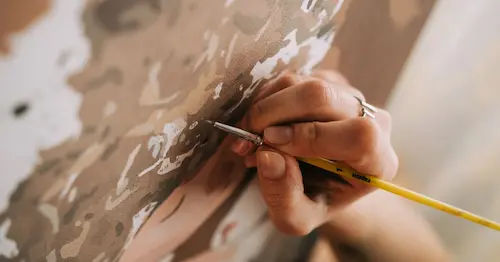Acrylic Painting Singapore

Painting with acrylic paint is a new world of colour for the beginner and improved possibilities for the professional artist in Singapore.
It offers an easy to use medium paired with astonishing expressive potentiality.
There are studios and workshops all over the island where you can not only learn and practice the art of painting with acrylic, but also improve your skills.
This Ultimate Guide To Acrylic Painting Singapore 2025 will walk you through the best places, tools and tips to help you get started in acrylic painting in Singapore.
Quick Summary
- Exploring Techniques and Styles: Discover various creative approaches and artistic styles in acrylic painting.
- Types of Acrylic Paint: Learn about different types of acrylic paints available for your artistic endeavors.
- Caring for Acrylic Paintings: Learn how to preserve your acrylic paintings so that they last a lifetime.
- Common Mistakes in Acrylic Painting: Identify and avoid common errors artists make when working with acrylics.
Getting Started with Acrylic Painting

To start painting with acrylics, you will need some basic supplies. The first is a good-quality set of paints in a range of shades. They should have good pigmentation, which will mean that a little paint covers a large area, and good lightfastness: that is, a good ability to stand up to light.
You need acrylic brushes in various sizes – possibly a flat brush for areas, a round brush for detail and a filbert brush for blending. Buy at least one stretched canvas or your chosen painting support (canvas boards, acrylic paper or even shiny paper for a collage), and a palette or palette paper for mixing colour.
Exploring Techniques and Styles

1. Brushwork
In your acrylic painting, experiment and play with application methods; the different effects that can be achieved through varying brushstrokes and how much pressure you use on the canvas can create a diverse range of outcomes, from broad, sweeping strokes, to tiny, delicate details.
2. Layering
Use transparent or opaque paint to create a sense of depth and dimension when working onto textured mediums or formica. This approach to acrylic painting enables you to create a sense of space and depth, strengthen the colours, and create interesting visual effects by revealing and concealing underlying layers.
3. Glazing
To apply glazes, paint thin, translucent layers of paint over already-dried layers in order to create a stained-glass-like luminosity. Glazing is a great way to create soft and subtle colour-shifts, deepen the vibrancy of your colours, and add depth and luminosity to acrylic paintings.
4. Texture Creation
Add texture to acrylic painting. Try adding texture (such as impasto, texture gels, applying material to the canvas, or other), which can both physically – and therefore also emotionally – interact with the viewer.
5. Styles
Acrylic paints offer many different styles for your expression. Free-form your feelings and emotions with unbound lines, textures and colours in abstract painting.
Document nature’s beauty and atmosphere with acrylic in a landscape painting. Finely focus your creativity through acrylic portraiture, still life or have fun mixing styles to find your artistic voice.
Acrylic Paint Grades

1. Student Quality Acrylic Paints
Student grade acrylic paints are cheaper than professional grade paints because they contain less expensive, less pure pigments than pro paints, which use the expensive ones, as well as more of the additives and extenders.
2. Artist Quality Acrylic Paints
The fewer additives or extenders such paints contain, the greater the chance of fading over the years. The fewer colours you use, the brighter they will be. Artist grade acrylic paints focus on each colour’s individual vibrancy.
Acrylic Painting: Tips To Paint Vibrantly

- Use two cups of water: Use one to rinse your brush to remove the excess paint and one to wet your brushes before they touch the canvas. This helps your paint colours look cleaner and brighter.
- Complementary colors: The colours that lie opposite each other are called complementary. When placed side by side, the warm and cool colours create a visually pleasing contrast.Blue and orange, or yellow and purple are complementary.
- Mixing complementary colors: You’ll mix different mud-like colours rather than a bright colour. Two complementary colours mixed together make a muddy colour which is similar to black. Never mix complementary colours haphazardly.
- Biased primary colors: The three primary colours — red, yellow and blue — are biased towards other colours. Does your primary colour have an association with another colour? Is it a warm yellow, a cool blue, an orangey red?
- Mixing biased primary colors: To make clean colours, blend two primary colours that have the same bias (or leaning) in opposite directions from each other. For example, a cool blue and a cool yellow that ‘lean’ toward green will combine to make a nice green; likewise, a warm blue and a cool red will combine to a nice purple.
- Don’t mix warm with warm: Warm hues of the primary colours can result in dirty colours. warm blue + warm yellow = dirty green. Because warm blue contains red and warm yellow contains red, the sum contains two doses of red that result in dirty green.
If you take these tips to heart, your acrylic mixes will be more transparent and vivid in hue, with no greyness or muddiness.
Common Mistakes in Acrylic Painting

1. Being Afraid to Make Mistakes
We get it. Our culture doesn’t reward acceptance of errors. Take risks in your painting to make better work – the more you experiment with a new technique, the better your work will be. You’ll know more next time, because you’ll have more experience with process, cause and effect.
2. Colour Mixing
The other thing beginners focus on is just having a huge range of colours. All you really need are blue, yellow, red and white, and mix them up and then you’ll be able to see it.’Experiment, see what happens. You might surprise yourself with what colours you can end up with.
3. Colour mixing part 2
Don’t squirt paint from the tubes for mixing, or you’ll end up with a mismatched colour. Use only a small amount of each colour for your lightest shade. Gradually mix in a little of the darker colour until you get the shade you want – it’s always easier to darken a colour than to lighten it, which is why you work in this order.
4. Take your brushes out of the water
If you leave your brushes in the water, you’ll damage your brushes very quickly because they’ll fray. You just lay them out of the water, and flat, so that the water will never get on it so much, that it runs all the way down and you get the glue of the brush all spoiled. That’s just art tips to save your brushes, if you do them all the wrong way.
5. Sufficient Paint or Water on your brush
If all you have is your last little bit of paint, and you’re too lazy to mix more, you can end up with patchy edges due to fluctuations in consistency, as well as running out of paint again and again, after every few strokes.
6. Blending mistakes
Blending softens strokes without mixing colours and, for the same reasons, use only a few strokes or it could turn out to be a mud. Or a paint-ring. Keep it simple with soft strokes.
Acrylic Painting Singapore
If you incorporate these practices and insights into your acrylic painting process, you’re well on your way to creating deeper, richer and more expressive work.
Remember, the essence of art lies in exploration and expression!
Frequently Asked Questions (FAQ)
If you have any questions about acrylic painting in Singapore, you can refer to the frequently asked questions (FAQ) about Acrylic Painting In Singapore below:
Can beginners with no prior art experience start their creative journey with an acrylic painting course?
Yes! You don’t have to be a fine arts major, people who want to learn painting and have no experience in a painting course so far would start their journey from painting basics. So, an acrylic painting course covers this scope as well, with all the materials provided as part of the program selected.
People who want to explore colours would start with the basics of colour theory. Painting, in general, is beginner friendly and it helps in pictorial composition.
Students are taught about various elements in a painting like understanding light and shadow, and shape, form, line, expression and texture. Acrylics is a good water soluble, highly coloured, fast-drying medium which is extensively used in contemporary art.
It dries sufficiently quickly to allow further work or layers of pigment without mixing, blending or fusing the upper layers and can be used both on canvas as well as paper. Hence, when one starts their journey with an acrylic course, they learn the basics of composition with acrylics and how it can be applied in all the mediums.
What are some acrylic painting ideas that help explore pictorial composition for art enthusiasts?
Recently, people have started exploring art and have a lot of interest and curiosity in vivid colours of acrylic paints.
Once someone is interested to learn and explore art, the first thing that they need to learn is the medium.
They can start with basic ideas on composing the picture. For example, what is light and shadow? What are different shapes, forms or perspective of craft? What is about colours and its contrast, as well as harmony? What are the different mediums you can use?
People paint still life, landscapes, abstracts or a portrait drawing.
All these ideas provide a canvas on which they can practice painting with acrylics and learn how to use different brushstrokes to create various effects.
They can also join art workshops which have a focus on guided learning opportunity from different teachers who possess a vast experience and training in various mediums of art, hence making it a richly encompassing experience
How can joining art workshops benefit individuals seeking to improve their acrylic painting skills?
Yes, art workshops are a great way to step into the world of art and identify what truly fascinates you. They help in sharpening your skills.
Different art teachers demonstrate a variety of acrylic painting techniques in class, especially working with various mediums like blending, layering and texturing acrylics.
They also talk about the richly coloured medium and understand its properties like fast-drying nature or its versatility for use on canvas or paper. In addition, it’s a great way to meet other art enthusiasts, exchange ideas and get feedback on your work.



